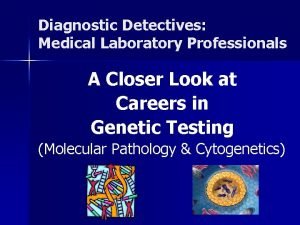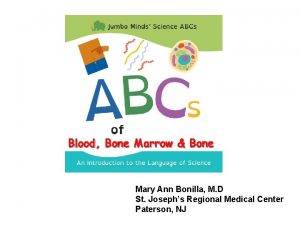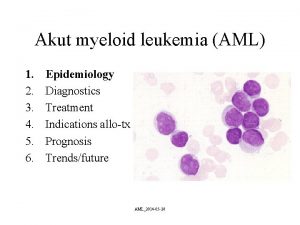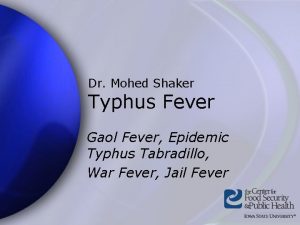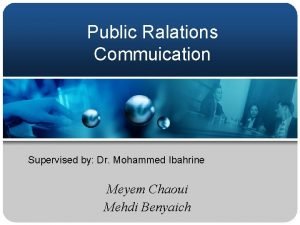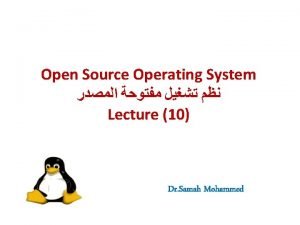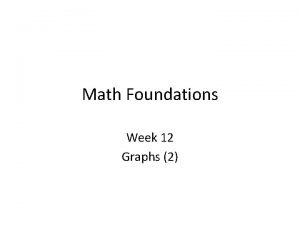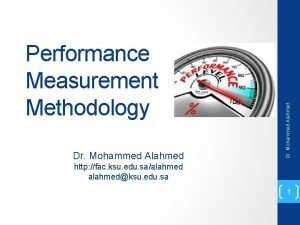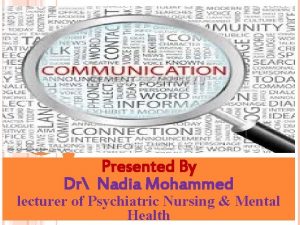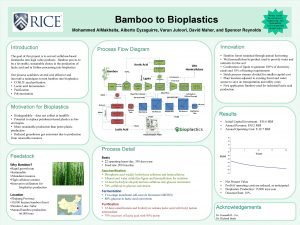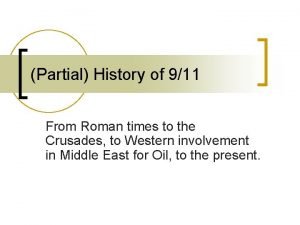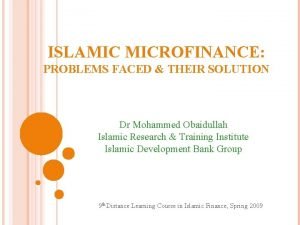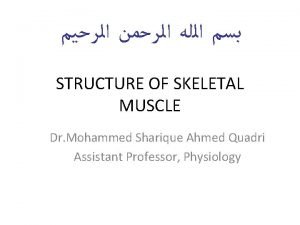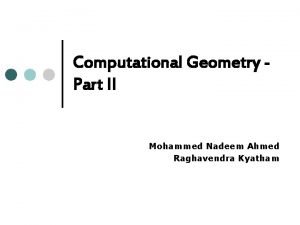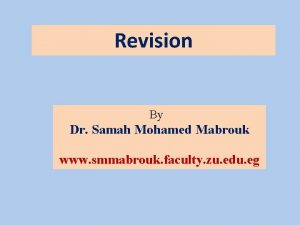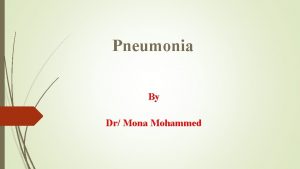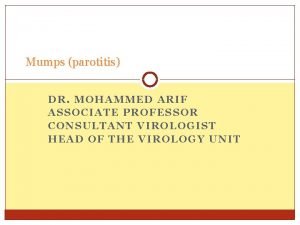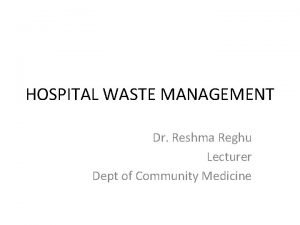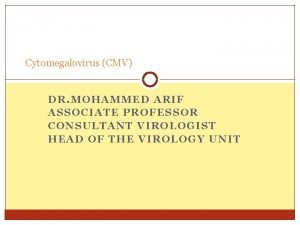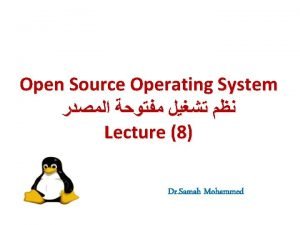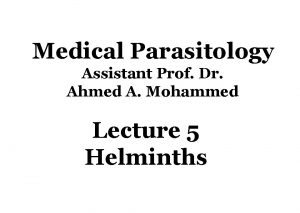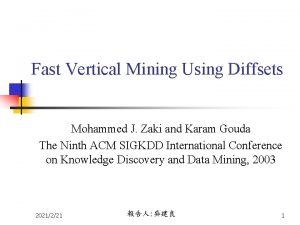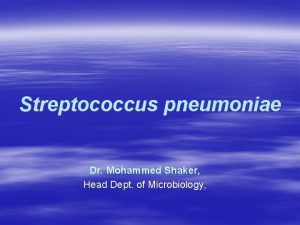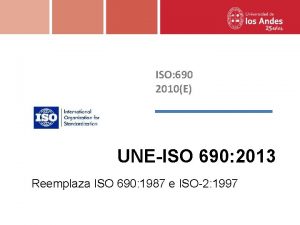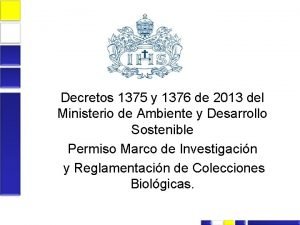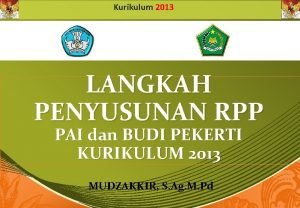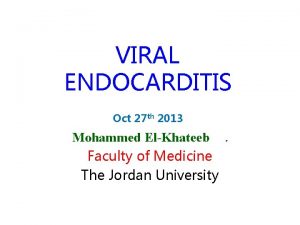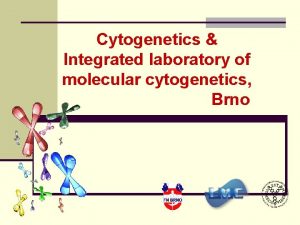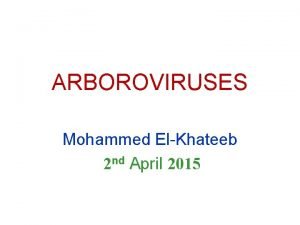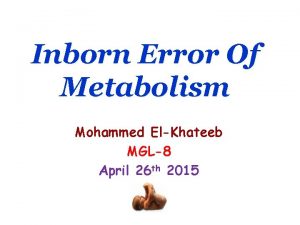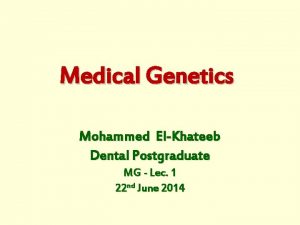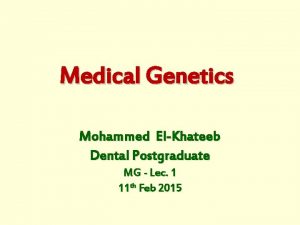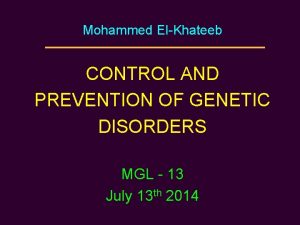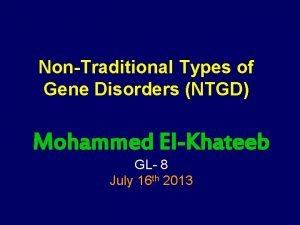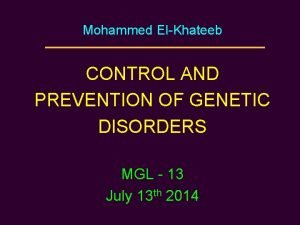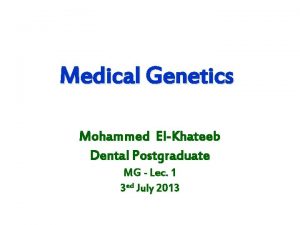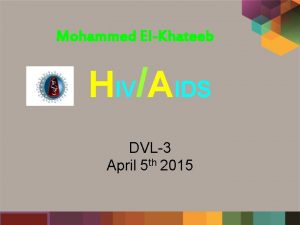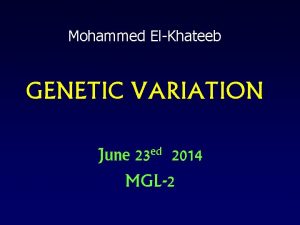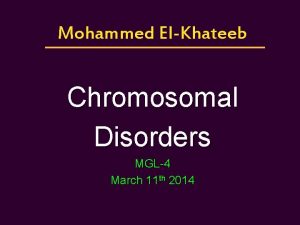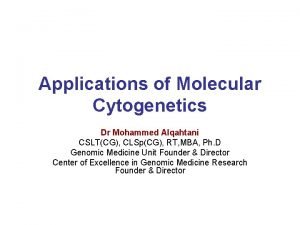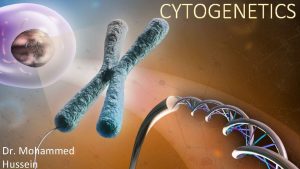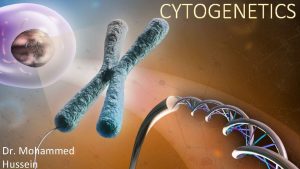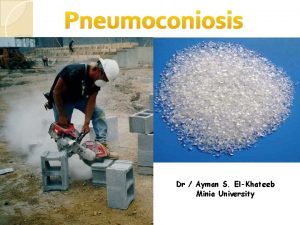Mohammed ElKhateeb CYTOGENETICS Cytogenetics MGL3 th 2013 th

Mohammed El-Khateeb CYTOGENETICS Cytogenetics MGL-3 th 2013 th Feb 17 June 24 2014 台大農藝系 遺傳學 601 20000 Chapter 1 slide 1

CYTOGENETICS • Chromosome Structure • Methods of Chromosome Analysis • Molecular Cytogenetics • Chromosome abnormalities • Chromosome Nomenclature

Cytogenetics The study of chromosome number, structure, function, and behavior in relation to gene inheritance, organization and expression

Fertilization Diploid Genome • • Each parent contributes one genome copy Offspring cells have two near-identical copies

DNA Coiling Leading to the Visible Structure of Chromosomes 2 nm 10 nm 300 nm DNA Nucleosomes 700 nm Chromatin Fiber Loop Chromosome Ø Primary coiling of DNA double helix Ø Secondary coiling of DNA double helix around the histone proteins to form nucleosomes Ø Tetiary coiling of nucleosomes to form chromatin fibres Ø Loops of chromatin fiber forming the chromosome

Chromosome Chromo = colored in response to dye Some = body Chromosome of Eukaryotes have been the traditional subject for cytogenetic analysis because they are large enough to be examined using light microscope Sister Chromatides

DNA Chromosome Repetitive Sequence (TTAGGG)n Telomere repetitive (satellite) sequence DNA Ccentromere Short (p-) arm Chromatid Long (q-) arm Repetitive Sequence (TTAGGG)n Telomere

What are telomeres? • Like the rest of a chromosome and its genes, telomeres are sequences of DNA chains of chemical code. • Like other DNA, they are made of four nucleic acid bases: A, T, G, C. • Telomeres are made of repeating sequences of TTAGGG on one strand of DNA bound to AATCCC on the other strand. Thus, one section of telomere is a "repeat" made of six "base pairs. "

Head Telomere Centromere Tail Telomere DNA Sequence for Telomeres: ttagggttaggg… ||||||||| aatcccaatccc… NOTICE: Tandem Repeats in Telomeres: ttagggttaggg… ||||||||| aatcccaatccc… Repeated 800 -1600 times in each Telomere

Telomere Tip of each chromosome § Seal chromosomes and retain chromosome integrity § Maintained by enzyme telomerase § Reduction in telomerase and decrease in number repeats important in ageing and cell death 8000 Telomere 3000 Length In base pairs 1500 Human Blood Cell 0 35 65

Visualizing Metaphase Chromosomes • Patient cells are incubated and divide in tissue culture. • Phytohemagglutinin (PHA): stimulates cell division • Colcemid: arrests cells in metaphase • 3: 1 Methanol: Acetic Acid: fixes metaphase chromosomes for staining

The steps in the process of creating a karyotype for chromosome analysis. Preparation of G banded karyotype Add a few drops of blood. Draw 10 to 20 ml of blood. Transfer to tube containing fixative. Specimens • Peripheral blood • Fibroblasts from skin bx • Epithelial cells from Add phytohemagglutinin to stimulate mitosis. Incubate at 37°C for 2 to 3 days. Transfer cells to tube. Add Colcemid to culture for 1 to 2 hours to stop mitosis in metaphase. Centrifuge to concentrate cells. Add low-salt solution to eliminate red blood cells and swell lymphocytes. buccal smear • Bone marrow • Solid tumor biobsies Drop cells onto microscope slide. Stain slide with Giemsa. Examine with microscope. Digitized chromosome images processed to make karyotype.

Chromosome Number in different animals and plants • • • Human 46 Chimpanzee 48 Dog 78 Horse 64 Chicken 78 Goldfish 94 Fruit fly 8 Mosquito 6 Nematode 11(m), 12(f) Horsetail 216 Sequoia 22 Round worm 2 • • • Onion 16 Mold 16 Carrot 20 Tomato 24 Tobacco 48 Rice 24 Maize 20 Haploppus gracilis 4 Crepis capillaris 6

Cytogenetics? • The study of the genetic constitution of cells through the visualisation and analysis of chromosomes. Ø G-banding Ø (and other traditional techniques) Ø Fluorescence in situ hybridization (FISH) Ø Molecular techniques Ø (QF-PCR, MLPA)

HOW DO SCIENTISTS READ CHROMOSOMES? • • • Size. This is the easiest way to tell two different chromosomes apart. Banding pattern. The size and location of Giemsa bands on chromosomes make each chromosome pair unique. Centromere position. Centromeres are regions in chromosomes that appear as a constriction. They have a special role in the separation of chromosomes into daughter cells during mitosis cell division (mitosis and meiosis).

Metaphase Chromosomes • Length • Centromere location • Satellite

Chromosome in general (size, shape and number) § § Two sister chromatids per chromosome DNA replication chromatids Two sister chromatids joined together at centromeres chromosomes differ in size and appearance with staining

Basic cytogenetic examinations Interphase cells Barr body (sex chromatin) Metaphase cells – staining of chromosomes § Solid staining § G-banding § R-banding § C-banding § Q-banding § Ag-NOR

Chromosomes as seen at metaphase during cell division Short arm p (petit) Light bands § Replicate early in S phase § Less condensed chromatin § Transcriptionally active § Gene and GC rich Dark (G) bands § Replicate late § Contain condensed chromatin § AT rich Centromere § Joins sister chromatids § Essential for chromosome segregation at cell division Long arm q q § 100 s of kb of repetitive DNA: some nonspecific, some chromosome specific Telomere § DNA and protein cap Telomere § Ensures replication to tip § Tether to nuclear membrane § provide terminal stability to the chromosome and ensure its survival

Chromosomes Banding Type Stain Area Stained Effect Q-banding Quinacrine Chromosome arms; mostly repetitive AT-rich DNA Under UV light, distinct fluorescent banded pattern for each chromosome. G-banding Giemsa Chromosome arms; mostly repetitive AT-rich DNA Distinct banded pattern for each chromosome; same as Q-banding pattern except single additional band near centromere of chromosomes 1 and 16 R-banding Variety of techniques Chromosome arms; mostly unique GC-rich DNA Reverse banding pattern of that observed with Q- or Gbanding C-banding Variety of techniques Centromere region of each chromosome and distal portion of Y chromosome; highly repetitive, mostly AT-rich DNA Largest bands usually on chromosomes 1, 9, 16, and Y; chromosomes 7, 10, and 15 have medium-sized bands; size of C-bands highly variable from person to person

High Resolution G banding High Resolution 400 -500 bands per haploid set • • 550 -600 bands per haploid set 800 -580 bands per haploid set Human chromosome 4 at varying resolutions due to exact mitotic stage, (or degrees of spreading - squashing - stretching) Each band corresponds to about 5000 -10000 kb

Low/High Resolutions Karyotype 7 18

Karyotyping

Autosomes are the first 22 homologous pairs of human chromosomes that do not influence the sex of an individual. • A • B Sex Chromosomes • C are the 23 rd pair • D of chromosomes that determine • E the sex of an • F individual. • G 1 -3 4 -5 + X 6 -12 13 -15 16 -18 19 -20 21 -22 +Y Idiograme A B C D E F G

International System for Human Cytogenetic Nomenclature (ISCN) • Regions, Bands & Sub-bands • § Each area of chromosome given number § Lowest number closest (proximal) to centromere § Highest number at tips (distal) to centromere 1 p 31. 1 § Chromosome 1 § Short arm § Region 3 , band 1, sub-band 1

Defining Chromosomal Location Arm p Region 2 1 1 Band 2 1 1 3 2 1 5 4 3 2 1 1 2 q 3 2 Subband 4 3 1 2, 3 4 1 2 3 Chromosome 17 17 q 11. 2

ISCN • • del - deletion dic - dicentric fra - fragile site i - isochromosome inv - inversion p - short arm r - ring • • der - derivative dup - duplication h - heterochromatin ins - insertion mat - maternal origin Pat - paternal origin q - long arm t - translocation

ISCN , Separates Chromosome numbers Sex chromosomes Chromosome abnormalities ; 46, XX, del(5 p) 46, XX, t(2; 4)(q 21; q 21) Separates altered chromosomes break points in structural rearrangements involving more than 1 chromosome Normal male 46, XY Normal female 46, XX

Cytogenetics? • The study of the genetic constitution of cells through the visualisation and analysis of chromosomes. – G-banding (and other traditional techniques) Ø Fluorescence in situ hybridization (FISH) – Molecular techniques (QF-PCR, MLPA)

Molecular Cytogenetics Ø Fluorescent Inistu Hypridization (FISH) Ø Different Fish Probes § Centromeric Probe § Chromosome specific unique sequence probe § Whole chromosome point probe Ø Reverse painting Ø Multicolor spectral karyotyping Ø Comparative Genomic Hypridization (CGH) Ø Flowcytometry

DIRECT FLUORESCENT LABELED PROBE Specimen DNA F T A A G T C G C A T G T COVALENT BOND F FISH Probe DNA

FISH technique is based on the unique ability of a single stranded piece of DNA (probe) to anneal or hybridize with its complementary target sequence on the chromosome

Advantages of Interphase FISH § Interphase cells for FISH do not require culturing of the cells and stimulating division to get metaphase spreads § 200– 500 cells can be analyzed microscopically using FISH § Monitor recurrent or residual disease in BMT pt. 33

Metaphase FISH § Uses fluorescent probes that bind to metaphase chromosomal regions or to whole chromosomes. § Whole chromosome paints: Probes that cover the entire chromosome, are valuable for detecting small rearrangements that are not apparent by regular chromosome banding. § Telomeric and centromeric probes are also applied to metaphase chromosomes to detect aneuploidy and structural abnormalities 34

Spectral karyotyping (SKY) and multiple fluoeescent hybridization (M-FISH) § By mixing combinations of five fluors and using special imaging software, can distinguish all 23 chromosomes by chromosome specific colors. § This type of analysis can be used to detect abnormalities that affect multiple chromosomes as is sometimes found in cancer cells or immortalized cell lines. 35

SKY Advantages: • Mapping of chromosomal breakpoints. • Detection of subtle translocations. • Identification of marker chromosomes, homogeneously staining regions, and double minute chromosomes. • Characterization of complex rearrangements. Disadvantages: • Very expensive equipments. • The technique is labor intensive. • Dose not detect structural rearrangements within a single chromosome. • Low resolution (up to 15 mb ). • Specific, not a screening method. 36

Fluorescence In. Situ Hypridization FISH 13 (green) 21 (red) X (green), Y (red) 18 (aqua)

Applications § § § § § Gene Mapping Chromosome Identification Aneuploidy Detection Sexing for X-Linked diseases Marker chromosome Identification Total chromosome Analysis Translocation Analysis Unique Sequence DNA Detection Microdeletion Syndrome Analysis Gene Amplification Analysis

Cytogenetics? • The study of the genetic constitution of cells through the visualisation and analysis of chromosomes. – G-banding (and other traditional techniques) – Fluorescence in situ hybridization (FISH) Ø Molecular techniques (CGH, QF-PCR, MLPA, Microarray)

Comparative Ggenomic Hypridization (CGH) Methods: • • • Isolate Genomic DNA from samples DNA digestion Label patient and control samples Hybridize to microarray Post hybridization washing Assay scanning and data analysis

Comparative Ggenomic Hypridization (CGH)

Comparative Genomic Hybridisation (CGH) Amplified gene = Green Reduction of gene = Red Flourochrom ratio = o. 5 – 1. 5

Reading a CGH-Microarray The resulting “colour” of a spot will depend on the ratio of “Red” and “Green” labeled DNA which has Hybridized to the Spot Equal Excess Patient DNA (Duplication) Loss of patient DNA (Deletion)


Indications - Postnatal • Multiple congenital anomalies • Developmental delay/ mental retardation of unknown origin • Autism • Any individual suspected of a chromosomal imbalance, even with normal karyotype • High resolution mapping to identify specific genes

Current Uses of Array CGH • Define congenital genetic defects • Define acquired genetic changes (in cancer) • Molecular fingerprints of specific tumors and subtypes • Identification of novel chromosomal regions for drug targets and new treatments

CGH Advantages whole genome in 1 experiment no need to culture tumor cells sensitive detection of gene amplification retrospective analysis Disadvantages limited resolution (~10 Mb del/dup) laborious only gains and losses / no balanced rearrangements no information on the nature of the aberrations

Sister chromatid exchanges

CHROMOSOMAL ABNORMALITIES

Types of chromosome abnormalities • Numerical § Aneuploidy (monosomy, trisomy, tetrasomy) § Polyploidy (triploidy, tetraploidy) • Structural § § § § Translocations Inversions Insertions Deletions Rings Duplication Isochromosomes
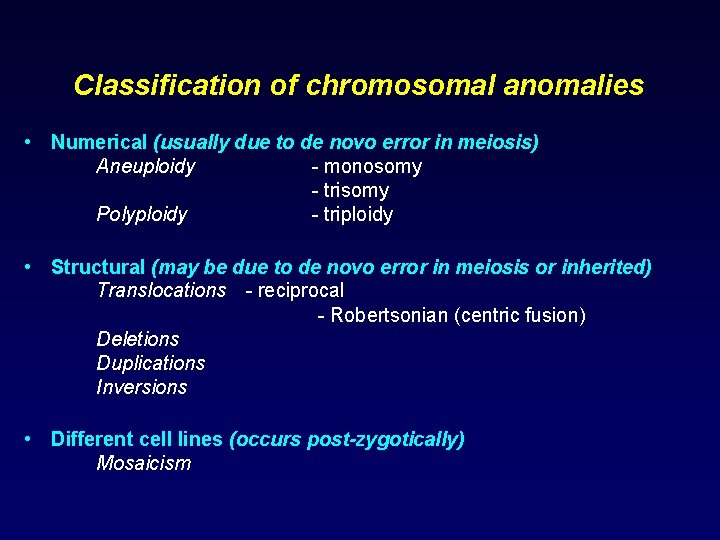
Classification of chromosomal anomalies • Numerical (usually due to de novo error in meiosis) Aneuploidy - monosomy - trisomy Polyploidy - triploidy • Structural (may be due to de novo error in meiosis or inherited) Translocations - reciprocal - Robertsonian (centric fusion) Deletions Duplications Inversions • Different cell lines (occurs post-zygotically) Mosaicism

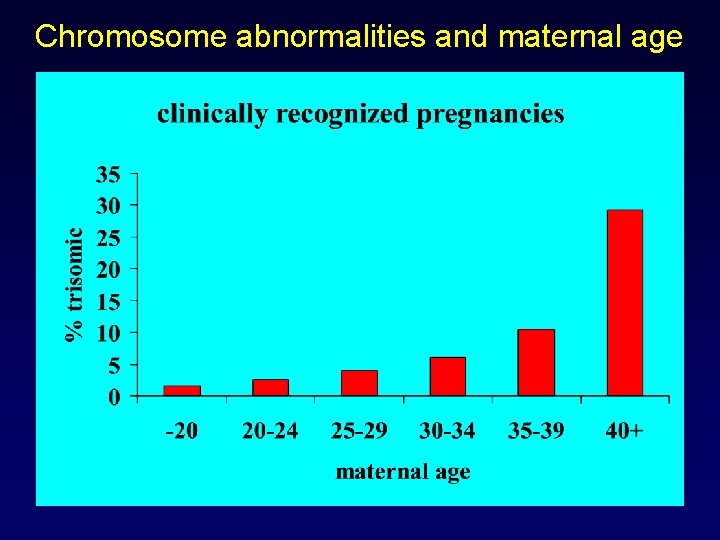
Chromosome abnormalities and maternal age
- Slides: 53
